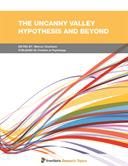Explore

The Uncanny Valley Hypothesis and beyond
Marcus Cheetham
2018
0 Ungluers have
Faved this Work
Login to Fave
A field of theory and research is evolving around the question highlighted in the Uncanny Valley Hypothesis: How does high realism in anthropomorphic design influence human experience and behaviour? The Uncanny Valley Hypothesis posits that a very humanlike character or object (e.g., robot, prosthetic limb, doll) can evoke a negative affective (i.e., uncanny) state. Recent advances in robotic and computer-graphic technologies in simulating aspects of human appearance, behaviour and interaction have been accompanied, therefore, by theorising and research on the meaning and relevance of the Uncanny Valley Hypothesis for anthropomorphic design. Current understanding of the "uncanny" idea is still fragmentary and further original research is needed. However, the emerging picture indicates that the relationship between humanlike realism and subjective experience and behaviour may not be as straightforward as the Uncanny Valley Hypothesis suggests. This Research Topic brings together researchers from traditionally separate domains (including robotics, computer graphics, cognitive science, psychology and neuroscience) to provide a snapshot of current work in this field. A diversity of issues and questions are addressed in contributions that include original research, review, theory, and opinion papers.
This book is included in DOAB.
Why read this book? Have your say.
You must be logged in to comment.
Rights Information
Are you the author or publisher of this work? If so, you can claim it as yours by registering as an Unglue.it rights holder.Downloads
This work has been downloaded 835 times via unglue.it ebook links.
- 272 - mobi (CC BY) at Unglue.it.
- 295 - epub (CC BY) at Unglue.it.
- 268 - pdf (CC BY) at Unglue.it.
Keywords
- affect
- anthropomorphic design
- Cognition
- Computer animation
- Computer graphics
- human likeness
- Perception
- robotics
- Uncanny Valley Hypothesis
- Virtual reality
Links
DOI: 10.3389/978-2-88945-443-3Editions

